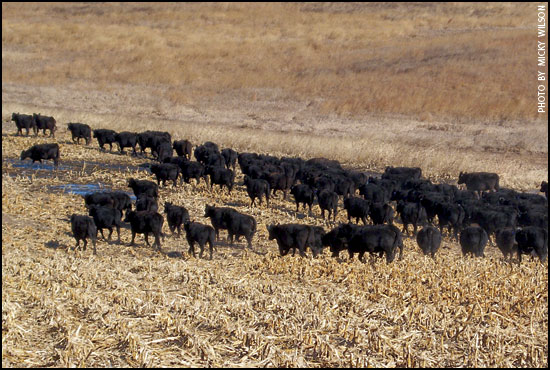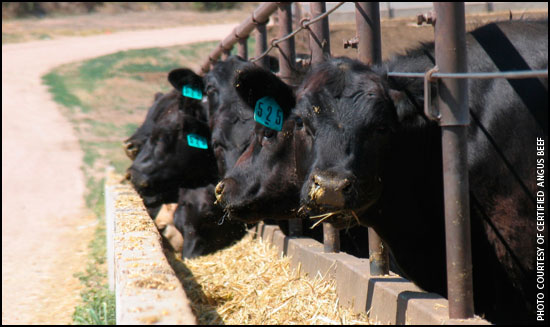MANAGEMENT...

Stalk Up on Strip-Grazing
Drive along the Corn Belt following fall harvest and a common site is cattle, mainly bred cows, grazing cornstalk residue. But there's more going on in that field than just cows munching on corn, especially if the field is managed with strip-grazing practices.
To learn more about managing cattle on strip-grazed crop residue, three things need to be kept in mind: management practices, supplementing vitamins and minerals, and soil compaction issues. Read more.
Economic Comparisons for Heavy Cows
When buying replacement heifers or cows, producers need to consider the relationship of their size preferences with cow performance and efficiency, said a University of Missouri (MU) Extension livestock specialist.
"Attend any cow or heifer sale and you will see that larger, heavier cows and heifers command the highest prices," David Hoffman said. "Cattle producers like to look at heavy cows in their front pastures, but do those big cows and heifers actually make more money?"
Maybe not. Hoffman cites a study from North Dakota State University (NDSU) that catalogued cows according to their average weight and respective performance. The heavier cows actually made fewer total dollars in terms of calf sales, Hoffman said.
Not only did the percentage of cow weight weaned decrease as cow weight increased, the actual weaning weight of the calves decreased, he said. For example, cows weighing 1,200 pounds (lb.) or less weaned 50% of their fall weight with 617-lb. calves, while cows that weighed more than 1,600 lb. weaned 34% of their fall weight with 572-lb. calves.
"Another economic consideration is the number of cows to have in your herd," Hoffman said. "If a farm is capable of supporting 100 head of 1,400-lb. cows, the same farm should have the capability of supporting 120 head of 1,200-lb. cows. The primary difference is the smaller cows would eat less forage. Most producers would like to sell an additional 16 to 20 calves every year."
Summertime Prescribed Burning Beneficial
It might sound crazy, but prescribed burning during the summer months is just as, if not more, effective than the traditional spring burns.
That was the message during the Division of Agricultural Sciences and Natural Resources Fire Field Day at the Oklahoma State University (OSU) Range Research Station.
"We're trying to get rid of the old mentality that people grew up with, that you can't burn in the summer because it doesn't benefit anything," said John Weir, OSU Cooperative Extension rangeland ecology and management specialist.
Jim Trapp, Oklahoma Cooperative Extension Service associate director, says producers can burn in any month of the year, including July and August, which actually may be better conditioned months to burn since burning conditions are more conducive and there are more days to potentially hold and complete a burn.
"If you restrict yourself to February, March and April, you may not be able to get the burning done that you should for the management practices that you're trying to achieve," Trapp said.

Ranch Homework for
Feedlot Partnerships
As a cow herd operator, you can produce a quality calf. The feedlot manager knows what it takes to finish that calf on feed so it can earn carcass premiums.
Combine the two sides as partners or retain ownership and the opportunities for herd improvement and profit may just multiply. But this equation only balances when you meet your "perfect" cattle-feeding counterpart.
There are thousands of feedlots, and hundreds could work for you, so finding the best partner can be a problem, especially the first time. Once you add up your needs, however, that formula should narrow the field. Finding the answer will lead to more math, but the feedlot and carcass data can help make the herd more predictable and add dollars to your bottom line. Read more.

Kris Ringwall
Beef Talk
Four points to think about.
Four things beef producers might want to think about are food safety, seamless regionalized calf-to-feedlot health connectivity, implementation of improved RFID (radio frequency identification) technology and value capture for the producer.
Realized or not, these four points have a significant impact on the beef industry. Producers want to maximize business options and maintain the flexibility to market their stock by utilizing methods that effectively capture value for the producer and enhance that value to all links in the beef industry. Read more.
Poisonous Plant Found in N.D. Rangelands
Several small patches of halogeton, a plant toxic to sheep, cattle and herbivorous wildlife, have been found in the Badlands area of western North Dakota, east of the Little Missouri River and north of Interstate Highway 94.
Previously unknown in North Dakota, halogeton plants contain unusually heavy concentrations of soluble oxalates, which are bound primarily as sodium salts. After ingestion, soluble sodium oxalates are readily absorbed into the circulatory system and eventually disrupt blood coagulation and nerve and muscle function, resulting in staggering and muscular spasms similar to milk fever. Liver and kidney function may also be affected.
About 1.5 pounds (lb.) of foliage can kill a sheep and about 3 to 5 lb. can kill a cow. As little as 12 ounces (oz.) of foliage can be fatal to animals in poor condition. Generally, cattle develop subacute symptoms from halogeton poisoning when abundant forage is available because the bitter taste of halogeton discourages consumption. Dead plants remain almost as poisonous as the living plants, according to NDSU specialists. Read more.
Prickly Pear Control
Research into the management of prickly pear cactus and its ecology is described in a new bulletin from the University of Wyoming Cooperative Extension Service (UW CES).
The authors of "Prickly pear cactus, ecology and management," MP-111.11, examine control methods carried out in Converse County and effects of spray treatment vs. mechanical means. Also examined is the foraging efficiency of cattle, determined by average bites per step.
Prickly pear cactus (Opuntia polyacantha), frequently referred to as plains prickly pear, is a widespread, thorny, succulent plant common throughout the Great Plains. Plains prickly pear has been identified as a serious impediment to livestock production on more than 5 million acres of rangeland in eastern Wyoming and eastern Colorado.
The bulletin is available for free download at http://ces.uwyo.edu/PUBS/MP111_11.pdf. Hard copies, for $2 each, can be ordered by accessing http://ces.uwyo.edu, clicking the Publications link at the top of the page then the Search Bulletins link, and typing MP-111.11 in the Publication Number box.

Ron Torell
Back to Basics
Washy grass
Do you know the difference between a puppy and a rancher? A puppy grows up and quits whining!
Seems you cannot satisfy agriculture people when it comes to moisture. We want moisture, but then whine about the results. Take for example this past spring. June brought more than 4 inches (in.) of moisture to the desert of the Great Basin region. This added moisture was accompanied by cooler-than-normal temperatures, making for ideal growing conditions. These ideal growing conditions produced an abundance of green grass. Out came the whining about washy feed, rain-damaged hay, weeds and increased fuel load for fire. It seems we just cannot stand prosperity.
In this issue of "Back to Basics" let's discuss "washy feed." Read more.
Temperature Transmitters for Cattle
Research at the University of Missouri (MU) has shown that internal transmitters may allow producers to use one or two animals in a group to determine whether the cattle are at risk for heat stress.
The transmitter is swallowed by the animal and lodges in the reticulum. An antenna can pick up the signal at distances up to 300 feet (ft.), and temperature can be checked as often as the producer wishes. A company in Oklahoma (SmartStock) makes the transmitters, and they are approved by the Food and Drug Administration (FDA), so cattle can go to harvest with these in their stomachs. The transmitters continue to function for 5 to 10 years, and producers/feedlots can retrieve them for re-use if they have an agreement with the harvest facility.
The researchers in Missouri are looking at various ways cattlemen can utilize information, such as body temperature of the cattle, to make good management decisions. A few signal animals in the herd or feedlot can let the producer know when animals are approaching the danger level, in time to initiate measures to cool them.
Panting Score Can Indicate Level of Heat Stress
Monitoring respiration rate of cattle can give a clue as to their level of heat stress. Researchers in Australia and Nebraska have collaborated to develop a panting score index that involves a combination of respiration rate and behavior.
The index includes the following scores:
0 — respiration below 40 breaths per minute (bpm). The animal is fine.
1 — 40 to 70 bpm. Breathing is typical of a warm day or mild exertion.
2 — 70 to 120 bpm. The animal is drooling, with mouth closed. The animal is too warm, and it is producing more saliva to carry away body heat via fluid loss.
3 — 120 to 160. The animal displays open-mouthed panting in an attempt to bring in more air to exchange for overheated air from the lungs. The neck is extended with head held upward, and the animal exhibits extensive drooling.
4 — greater than 160; too fast to count. The tongue is fully extended out of the mouth, excessive drooling, head extended upward.
5 — Respiration is variable, head is hanging low. The animal is so dehydrated it may stop drooling. The animal is going into shock (heat stroke), and death is imminent.
Stage 3 is the point where cattle need to be cooled down, or rested if they are being worked or moved on a hot day and become overheated.




